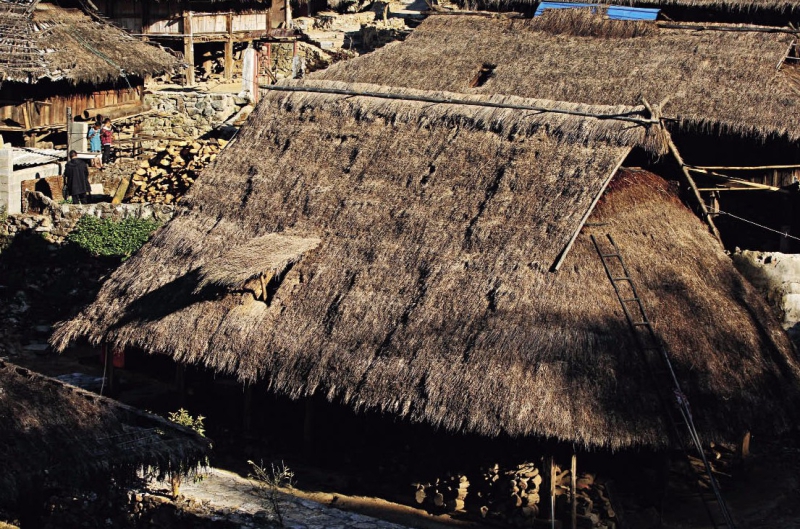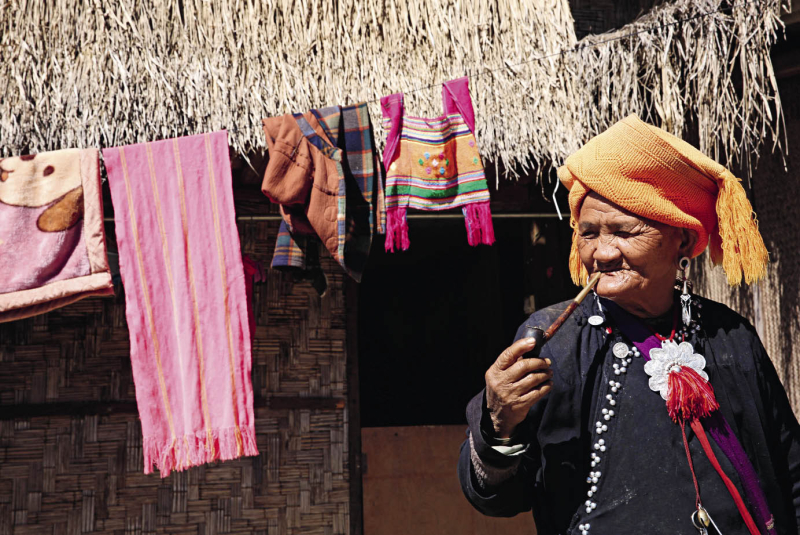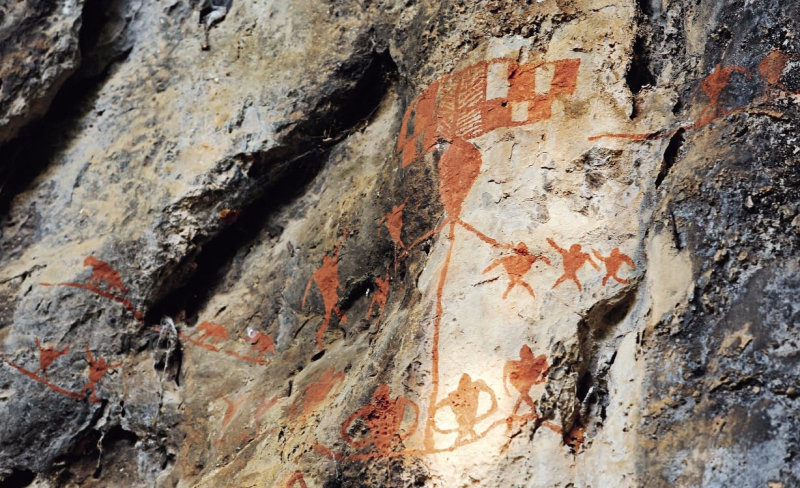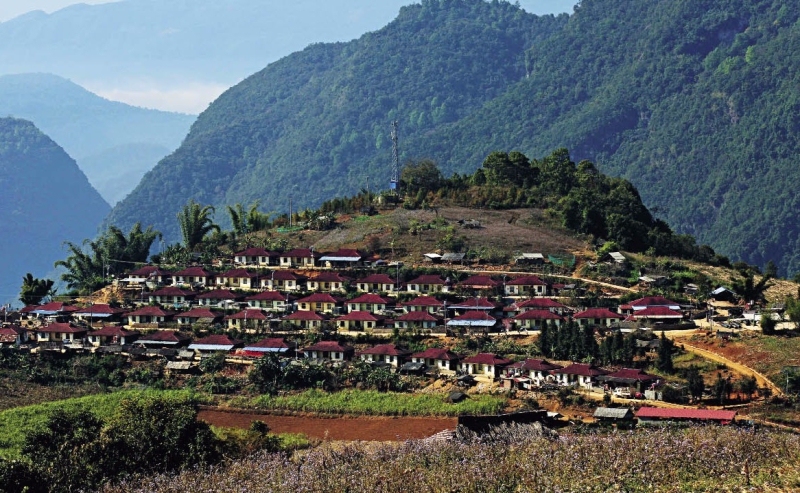
The county of Cangyuan has the title of “City of Eternal Spring.” The mountains in the region are connected to the Laobie Mountains of the Nushan Mountain range. There are so many mountain peaks in the region that it is hard to find any flat land, and the area is filled with numerous varieties of plants and animals. In addition to this, it also has well preserved villages that have maintained their traditional culture and way of life for hundreds of years, exhibiting a living example of how humans and nature can live harmoniously together.
Mesozoic Era Survivors and Ancient Cliff Paintings
A particular tree species in this area is a secondary national protected rare plant called caryota urens or caryota obtusa. The caryota obtusa forest has been called the living fossil of the plant world and was once a staple food of dinosaurs. During the cretaceous period, this type of tree covered the whole world, but later with global climate changes, it slowly disappeared. Here in the Menglai canyon in Cangyuan, this plant flourishes everywhere. Caryota obtusa trees are accustomed to growing on high mountain peaks and grow straight upwards regardless of the height of the peak, symbolizing the upright and brave Wa people.

An elderly woman walks through Wengding Village.
Providing company to the caryota obtusa tree are the Cangyuan cliff paintings that depict the life of the Wa people. Two large rock paintings illustrate as it were, two beautiful laws of nature: Nature gives birth to life, and life is the foundation of history. The ancestors of the Wa people painted scenes of their daily life on cliff walls deep in the mountains, including scenes of hunting, shepherding, village life, dancing, acrobatics, and religious sacrifices. The structure of the paintings is simple, and the animals and people portrayed are vivid, portraying the glimpses of a time and place long forgotten. It was 3,500 years ago that the Wa people used a combination of crude ore powder, plant sap, and animal blood to create those paintings on the cliff walls in Menglai. The paintings depict the history, religion, culture, and art of the Wa people, recording the code of human life and civilization.
Oral traditions regarding the origins of the Wa ethnic group are recounted in the epic Sigangli, which is a story about how the world began. In the story, ancestors of humans are depicted as emerged out of a cave. The meaning of the word “sigangli” in the Wa language means emerging out of a cave. Rock paintings have been found at 15 different locations, one of which has been given the name “Cave Life Painting” by scientists, for it portrays an opening with many layers of rocks around it and crowds of people standing around the entrance watching people struggling to come out of the cave opening. Some of the portraits of people and animals were drawn with simple straight lines while others depicted the beautiful natural shapes of people’s physical figures.
One legend says that the Cangyuan cliff paintings were left behind by tribes as a sign to direct people who came later to their new location. Another legend says that the rock paintings recorded the excitement of people following the creation of the world, while still other legends say that the paintings depict the goddess called Meiyiji telling the Wa people how to conduct physical labor and enjoy life.
Guardians of the Tiankeng
Bankao Village in Cangyuan consists of 17 groups, one of which is located in the caryota obtusa forest valley. Even though local dwellings maintain the traditional Wa people’s stilt-houses, the houses here are not thatched. The houses were designed and built by the government in an effort to provide comfortable and fully furnished living quarters for the local people.

Prehistoric cliff paintings located in Cangyuan.
Dancing has always been a part of Wa culture. During a wedding in Bankao Village, a ceremony is held in a typical Wa house’s courtyard, and enchanting music that resembles river water cascading down the mountains begins with a simple rhythm and easy to follow lyrics. After some people begin to sing, more people join in the dancing, most of whom wear traditional attire that consists of black dresses and embroidered blouses decorated with silver beads on the collar, chest, cuffs, and hems of the gown. Their heads are covered with a colorful piece of cloth, and they carry a white embroidered bag with tassels hung diagonally across their chest. They also wear large round earrings, a large, thick silver necklace, many thin necklaces, and wide bracelets engraved with exquisite patterns. When dancing, the movement of the whole body presents a scene of light bouncing and glancing off silver. Jewelry worn by women is very similar to that on people depicted in the cliff paintings. As for men’s apparel, their clothing style has greatly changed over time and now resembles Han men’s clothing.
The Tiankeng (large sinkhole) can be seen from the village. There are seven such sinkholes in Cangyuan. Standing at the top, one cannot see the bottom of the abyss. There are many legends regarding the sinkholes, one of which has been passed down among the Wa people and firmly believed by them for hundreds of years. It tells of a mysterious connection between the sinkhole and cliff paintings. According to legend, a Wa man was collecting honey on the cliffs one day when he discovered the sinkhole. Later he returned to his village and told the chief of the village what he had seen. He knew the entrance to the cliff paintings was a secret but could be opened. The chief, on the other hand, fearful that some disaster might befall his people if the door should be opened, strictly forbade the man from opening the door. The chief also strictly prohibited anyone from going near the sinkhole. But after some time had passed, some locals secretly descended into the sinkhole to find a kind of herbal medicine which they believed could make people immortal. Surrounding the medicine were poisonous snakes and insects, making it difficult to get. Believed to be an entrance to another world and the site of a herb that could make people immortal made the already mysterious sinkholes even more fantastical in people’s minds. The Tiankeng has become yet another mysterious symbol of the Wa people.
Today, medical care and education in Bankao Village is free, and the daily life of the local residents is no different from that of any other village in China, having access to all the daily consumer goods and amenities of a modern life, cellphones, beer, cars, and so on.
Daily Life of the Ancient Wengding Village
Wengding, which means a place engulfed by clouds and mist in the Wa language, is a mountain village with over 400 years of history. In the past, Wa people lived in a remote area and used primitive techniques of slash and burn to carry out their farming. After the People’s Republic was founded in 1949, people’s lives quickly ushered in modernization of society while still retaining many aspects of their former, traditional ways. The ancient village of Wengding has preserved most completely the traditional architecture style of the Wa people as well as their ancient traditions and customs.
The language of the Wa people has no common written form of its own, but rather uses objects and wood to record things, numbers, and pass on messages. On the totem pole of the goddess, it records of mountains and rivers, eating and meeting etiquettes, planting, and harvesting, an ever-burning fireplace, and the beating of drums.

Lines of unifiedly designed houses of Bankao Village’s Group No.13 in Cang-yuan decorate the local mountain scenery that surrounds them.
Near the totem pole of the goddess is the magnificent architecture of the Wa Palace. Built during the period of Emperor Guangxu (1871-1908), the Wa Palace was a gift from the Qing Dynasty to a tribal chief Banhong as a reward for his efforts of mediation in border affairs. The emperor awarded him with the title of “Regional Chief of the Banhong” and gave him the surname of Hu. As a result, the seat of the local government was called the Wa Palace.
The fire pit is the public area of Wa people’s homes that is used for the living room, kitchen, and dining room, as well as the room for entertaining guests. Across from the entrance to the south of the fire pit is the place solely for the master of the house to sit. According to local customs, male guests enter the home first before female guests, in honor of men. There is always a fire burning in the fire pit that is not allowed to go out. Wa people worship fire, so consequently, every home has a fire pit. The fire is lit after the New Year Day and burns continually until the beginning of the next year. During the new year’s celebrations, the fire is extinguished and re-lit. Every year, the new fire is brought from remote location in the wild outside the village, symbolizing the taking of the soul of the mountain and water. Each year the ceremony of lighting the new fire is carried out by highly respected elders of the village.
Over 100 families living in the ancient village have already moved to the new village built by the government, while one seventh of the families remained in the old village to take care of it. Those families who moved away return every year to the old village to celebrate holidays with singing and dancing.
Life for the ancient Wengding tribe begins at sunrise and ends at sunset. Their daily life consists of farming grain, feeding poultry, weaving cotton material, sewing clothes, attending the fire pit, and cooking food. Traditionally, people live in homes made of bamboo and wood with thick layers of twitch-grass covering their roofs. A small transom window is propped open by wooden poles, and a long wooden ladder rests on one side of the house available for the family to use to fix the thatching on the roof when needed. Wa people’s worship of ox totems can be seen by the design of their houses. Horn-shaped beams are placed in the open air to protect the old and young. The upper level of the bamboo building is the living quarters of the family, while the lower level separated by a wooden floor is for storing sundry things and livestock. Outside, a small courtyard is surrounded by a low stone wall. A network of rough stone paths beyond the walls leads to the rest of the village, connecting each house throughout the village. At the edge of the village, there are small wooden huts, green and mossy at the bottom of the pillars. Doors here are left ajar at night.
At the center of Wengding Village stands a simple grass pavilion, called the Sala House in the Wa language, where people can rest and hold meetings together.
Wa people worship the god of trees. The village is surrounded by forests on all sides, and no one is allowed to log the forests for lumber.
Wa people will only cut trees down during the wooden drum festival. After gaining permission of the gods through sacrificing cattle by the local sorcerer, young men go out at night time to cut down trees. The next day, the entire village, both old and young, dress up in costumes, sing, dance, and begin to pull the trunk of the tree back into the village to make wooden drums. Wa people regard wooden drums as an object of spiritual worship, believing that the sound of drum can reach the gods, expel demons, and bring good luck. The decoration of the wooden drum room also features heads of oxen. The number and size of ox heads demonstrates the wealth of a village.
_______________
ZHAO YANQING is a columnist.